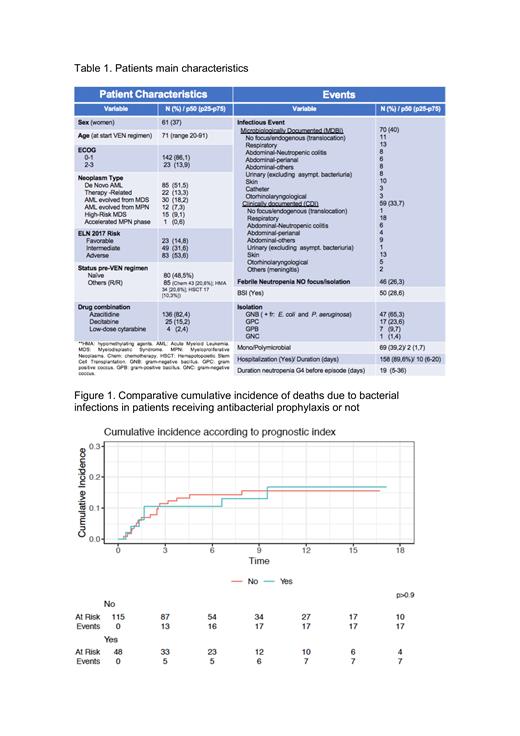Background and aims: The addition of Venetoclax (VEN) to the treatment of myeloid neoplasms, particularly newly diagnosed and relapse/refractory (R/R) Acute Myeloid Leukemia (AML), has shown improved responses compared to hypomethylating agents (HMA) in unfit patients. Nevertheless, side effects derived from deep cytopenias (infections) could potentially be a caved of such strategy. The use of antibacterial prophylaxis in this setting is controversial and its employment heterogeneous across centers, making difficult to draw conclusions from real-world studies.
In this study we aimed to ascertain whether the use of antibacterial prophylaxis has an impact on the incidence of bacterial infections, hospitalization rates, infection severity, and mortality due to the infection. Finally, we also aimed to identify potential risk factors for bacterial infections.
Methods: Retrospective data collection of patients with de novo, R/R or secondary AML, High Risk Myelodisplastic Syndrome and accelerated phases of Myeloproliferative Neoplasms treated with HMA or low dose cytarabine + VEN between January 2018 and May 2023 in 10 Spanish centers. Baseline characteristics and infectious episodes [presented as Microbiologically Documented Bacterial Infections (MDBI) or Clinically Documented infections without Isolation (CDI)], or febrile neutropenia without isolation or focus (FN) were recorded. Confirmed or suspected infections of parasites/fungi/viruses were excluded in this study. For each event, antibacterial prophylaxis, days of hospitalization, severity, disease status and dead due to infectious events/FN were collected.
Results: In total, 165 patients have been included (clinical characteristics summarized in Table 1). VEN was initially used as 28 days/cycle and it had to be adjusted in 78 (48.75%) patients, mainly due to cytopenias and infections. The univariate analysis showed that infectious events and FN occurred more frequently in patients with high ELN risk than in those with Intermediate/favorable (OR; 2.71, 95% CI; 1.03-7.11, p = 0.041).
In our cohort, 175 infections (MDBI/CDI) or FN occurred in 113 patients (68.5%) with an incidence of 26.1/100 cycles. These episodes correspond to 70 (40%) cases of MBI, 59 cases of CDI (33.7%) and 46 (26.3%) cases FN, with a median of 1 episode per patient (range 1-5). Most events occurred in the first (85; 48.9%) and second cycle (43; 24.7%) with a median of cycles at the moment of the event of 2 (p25-p75: 1-3) and a median time from VEN start to episode of 44 days (p25-p75: 18-105) because infections/FN usually led to delays on subsequent cycles. Considering the total number of events in patients with at least first disease evaluation available at the time of infection, only 48 (31%) had cytologic response (<5% blasts). Table 1 shows type of episode/isolation/focus.
Antibacterial prophylaxis was used in 48 patients (29.5%), primarily with quinolones (levofloxacin 74%, ciprofloxacin 23%) according to physician decision. Incidence of infections (MDBI/CDI) or FN was lower in patients with antibacterial prophylaxis (OR; 0.37, 95% CI; 0.18-0.74, p = 0.05). Additionally, the median number of infections was lower in prophylaxis group (0.77 vs 1.18; p= 0.004). However, no differences were observed between both groups regarding hospitalization incidence or infection severity (defined as need of vasoactive drugs, high-flow oxygen therapy or deaths caused by the infectious episode).
Microbiological isolations were significantly higher in non-prophylaxis group with infections (45.6% vs 23.7%, p 0.015). Incidence of multidrug-resistant organisms was 10.2% among all patients, with no differences between groups neither in Clostridioides difficile incidence (3.6%).
In the competitive risk survival analysis, cumulative incidence of death from MBI/CDI or FN cause showed no differences between patients receiving or not antibacterial prophylaxis ( p= 0.98) (Figure 1).
Conclusions: Our data suggest that avoiding antibacterial prophylaxis in non-intensive VEN-based treatments may result in a higher incidence of FN and infectious events, but it does not lead to impaired outcomes in terms of severity and/or mortality related to infections. Having a greater availability of microbiological isolations could enable more targeted antibiotic therapy, avoiding drug resistance. Additional data from the prophylaxis cohort will be included in the presentation.
Disclosures
Molero Yordi:Gilead: Honoraria; BMS: Honoraria; BioTest: Honoraria; Novartis: Honoraria; Jazz Pharmaceuticals: Honoraria; AstraZeneca: Current Employment; Oryzon Genomics S.A.: Consultancy. Escolano Escobar:Pfizer: Honoraria; Sandoz: Honoraria. Ruiz Camps:BMD: Honoraria; Astra-Zeneca: Honoraria; Janssen: Honoraria; MSD: Honoraria; Gilead: Honoraria; Pfizer: Honoraria. Fox:GSK: Consultancy, Honoraria; BMS: Honoraria; Novartis: Consultancy, Honoraria. Salamero:Jazz: Consultancy, Honoraria; BMS: Consultancy, Honoraria; Pfizer: Consultancy, Honoraria; Astellas: Consultancy, Honoraria; Abbvie: Consultancy, Honoraria.


